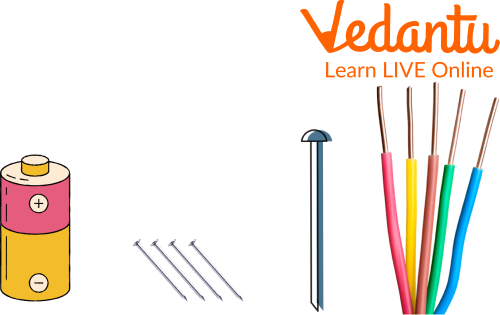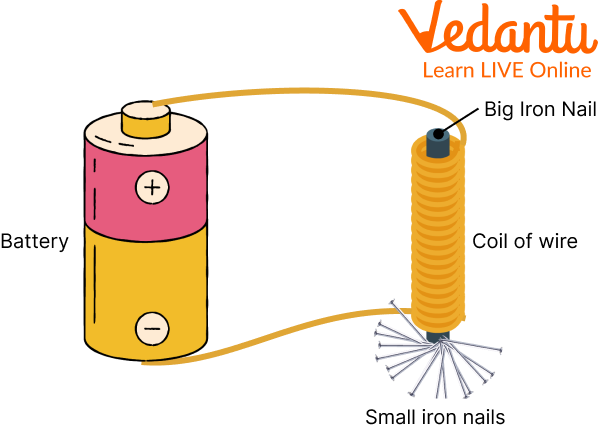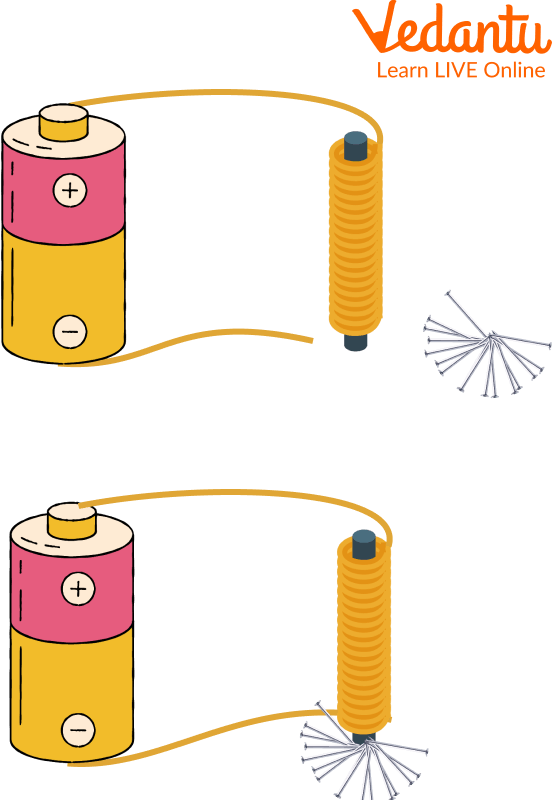




Overview of the Simple Electromagnet
Have you ever wondered how to make an electromagnet? So, before going on to it, let’s first know what a simple electromagnet is. It is a type of magnet that generates a magnetic field by using an electric current. It has the ability to attract and magnetise ferromagnetic elements such as iron, nickel, and cobalt. A basic electromagnet can be easily constructed at home using common household components.
In this article, you will learn how to make a simple electromagnet, as well as how to make one at home. You'll also find out what things are necessary for the process, and get a description of how it actually works. Below are images of electromagnet.

An Electromagnet
How to make an Electromagnet at home?
You might be wondering how to make an electromagnet. Is it that simple? Can it be made at home? A simple electromagnet can be made at home only. The following are the things required to make an electromagnet:
A plastic insulated thin wire
A battery of 5 volts
Some small nails that are made up of iron
A big Iron nails

Things Required to make an Electromagnet
Steps to Prepare
Wrap 20 turns of insulated wire on an iron nail firmly.
Trim about an inch of plastic covering from the two ends of the wire.
Attach one end of the wire with the positive terminal of the battery, and the other with the opposite terminal. Utilising the electric wire tape is vital.
Get some iron nails and bring your electromagnet close to them. You will see the iron nails will be drawn in towards your electromagnet.
Separate wires from the battery, if the wire or battery gets hot.
The image of an electromagnet is shown below:

Preparation of Electromagnet
How Does Electromagnet Work?
At the point when you connect the wires to the battery, an electric current flows into the wires. This electric flow creates the magnetic field around the wire. The iron nails act as a magnetic core. Magnetic cores are utilised to improve the magnetic field.

Working of Electromagnet
Give It a Try!
You can use this method to know practically about the electromagnet. Attempt to utilise two 1.5 volts AA batteries, and attach them in series. Then, connect the wires to this battery and notice the impacts. Find out, does it influences the strength of the electromagnet
Use a thicker wire rather than a thin wire, and fold over the iron nail. Then, at that point, notice the strength of an electromagnet.
Use thick iron nails or bolts. Then, at that point, they notice does it influence the strength of an electromagnet.
Attempt the above techniques, and note down your outcome. Eventually, you will find which strategy is influencing the strength of the electromagnet most.
Magnetic Field of an Electromagnet
The magnetic field of an electromagnet is produced by the flowing electric current. The wire which is turned around the magnetic core is made from a ferromagnetic material such as iron. The current flowing through the wire creates a magnetic field which is concentrated in the hole.
Advantages of Electromagnet
The main advantage of an electromagnet over a permanent magnet is that the magnetic field can be changed as per our requirement just by changing the amount of electric current flowing in the wire. Electromagnets are widely used in electrical devices, such as generators, motors, loudspeakers, MRI machines, and solenoids. These magnets are also for picking up and moving heavy objects in the industry. The poles of electromagnets can be changed by changing the direction of the electric current. They are also inexpensive and lightweight.
Summary
An electromagnet is the sort of magnet which utilises electric flow to make an attractive field. It can draw in and charge ferromagnetic materials like iron, nickel and cobalt. Making a simple electromagnet at your home from household materials is easy. Electromagnetic devices comprise a centre of magnetic material encompassed by a coil through which an electric current is passed to magnetise the centre. An electromagnet is utilised in any place where controllable magnets are expected, as in contraptions in which the magnetic flux is to be changed, turned around or turned on and off.
FAQs on How to Make an Electromagnet?
1. Describe the common physical properties of magnets.
The physical properties of a magnet are that it is attracted to iron and steel, which are also magnetic; it is malleable and conductive i.e. it can be stretched and moulded into any shape; it has a natural 'north' and 'south' pole, just like the Earth and its field extends far away from its body, just like Earth's magnetic field does (its parts attract due to opposite poles).
2. What are the uses of an electromagnet?
The primary benefit of an electromagnet over a permanent magnet is that the magnetic field can be immediately different by controlling how much electric current is in the winding. In any case, not at all like a permanent magnet that needs no power, an electromagnet requires a continuous supply of current to keep up with the magnetic field. Electromagnets are broadly utilised as parts of other electrical instruments, for example, engines, generators, electromechanical solenoids, transfers, amplifiers, hard plates, MRI machines, logical instruments, and magnetic separation instruments. Electromagnets are additionally utilised in industry for getting and moving weighty iron articles, for example, scrap iron, and steel.
3. When was electromagnet first discovered and how was it shaped?
Electromagnet was first discovered by British scientist William Sturgeon in 1824. The first electromagnet was shaped like a horseshoe. It was a piece of iron which was shaped like a horseshoe and was wrapped with about 18 turns of copper wire.
4. Differentiate between permanent magnet and electromagnet.
A permanent magnet is made up of such material which creates its magnetic field that is constant i.e. it cannot be changed, whereas an electromagnet creates a magnetic field due to electric current flowing through the wire which is turned around its core and its magnetic field can be changed by changing the electric current flowing through the wire.









